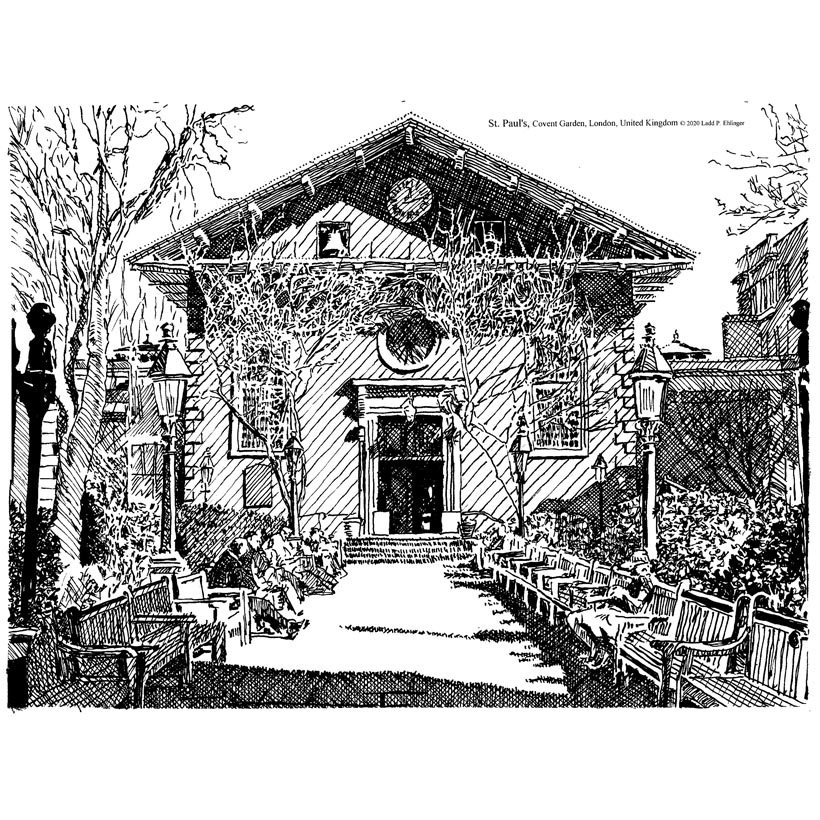
Projects Newsletters Personnel Contact

The west front of St. Paul's in Covent Garden, London, United Kingdom is the subject in the print of a sketch by Ladd P. Ehlinger, AIA. The 4th Earl of Bedford received permission from King Charles I in 1630 to demolish buildings in an area north of Strand that he owned and to redevelop it into Covent Garden Piazza, the first public square with terraced residences arcaded below for a market area in London. There also was a theater later on in the development. St. Paul's is on the west end of the Piazza. The design commission for Covent Garden and the church was given to the architect Inigo Jones by the Earl of Bedford, who in typical developer fashion, cautioned Inigo Jones to design a simple church “not much better than a barn”. Jones replied “Then you shall have the handsomest barn in England.”
St. Paul's was completed in 1632 (the year the most famous English architect Sir Christopher Wren was born), and thanks to Inigo Jones really is a very handsome building in the Renaissance style, executed in the simplest means possible in classical proportions. What is actually seen today is a rebuilding that took place at the hand of architect Thomas Hardwick (1752-1829) after it was burned in 1795. The west facade was retained along with the other outer masonry walls north & south, but the east facade portico was totally rebuilt.
Inigo Jones was one of the most important figures in the architecture of England in the 17th Century as he single handedly initiated and advocated the Renaissance style in England. The son of a cloth maker, nothing is known of his early life and education. In the early 1600s, he was employed by Queen Anne, wife of James I, to provide costumes and settings for a bal masque at court, something he continued to do even after he began designing buildings. His first known building was the New Exchange in the Strand in London done in 1608. He made several trips to Italy to study Classical and Roman architecture, and the Italian Renaissance buildings, particularly those designed by Andrea Palladio. St. Paul's was obviously inspired by Palladio. After one of his trips to Italy in 1613, he was appointed surveyor to the King, a position he held until 1643 when there was a civil war. Jones died in 1652.
The east front of St. Paul's is actually facing the Piazza and has a four columned temple type portico that is more elaborate than the west facade of the sketch. This facade is the one most often depicted in architectural history text books, yet I think it lacks the simple dignity of the west facade shown in the sketch. There are some historians that believe that Inigo Jones intended to reverse the normal order of placement of the altar on the east end to the west end, and ran afoul of Church of England officials who refused to allow it. Thus the entrance to St. Paul's is on the plain west front through the grave yard, and the altar is on the traditional east end.The interior of St. Paul's is equally as simple. A single raised step at the east end is the demarcation of the Chancel area from the Nave of the church. There were at one time balconies added on three sides, but in various re-buildings over the centuries, this has been reduced to one for the choir in the rear next to the two adjunct rooms on either side. There are two rows of columns each centered on the pews. The net visual appearance is that of a unified single space with very pleasant proportions as per the exterior.St. Paul's is also known as “The Actor's Church” as the actors that played in the Theater Royal nearby, and later the Covent Garden Theater (now Royal Opera House) that opened in 1723 frequented the church. Their participation also served to attract various artists of other disciplines as well. Some productions have been presented in the south portico of the church also. Various actors and artists were initially buried at St. Paul's, though since 1852 there have been no burials. There are wall plaque memorials in the church to many famous 20th century acting personalities in addition to 17th and 18th century figures, such as Sir Charlie Chaplin, Sir Noel Coward, Gracie Fields, Stanley Holloway, Boris Karloff (the monster in Frankenstein movies), and Vivien Leigh (Scarlett O'Hara in “Gone With the Wind”).
Ladd P. Ehlinger, AIA